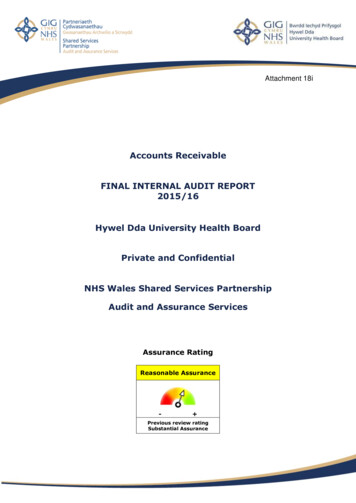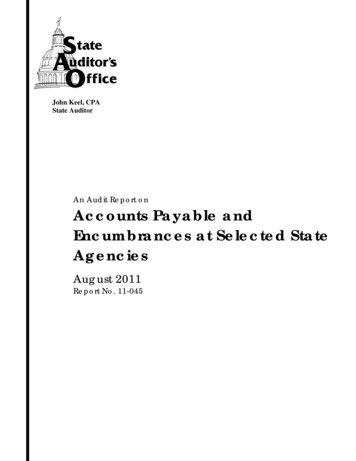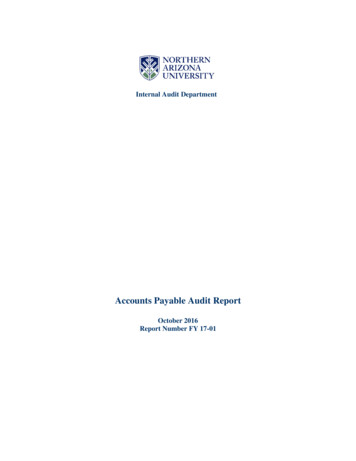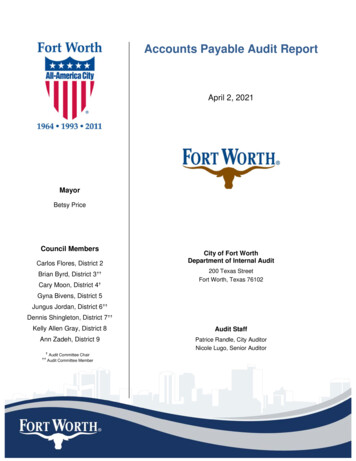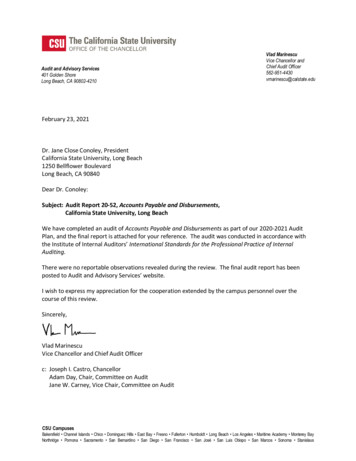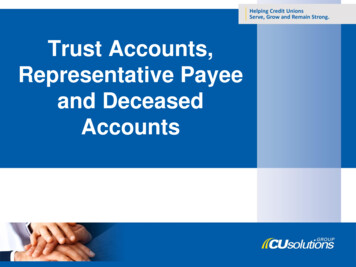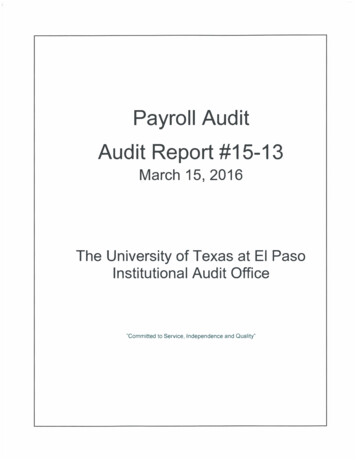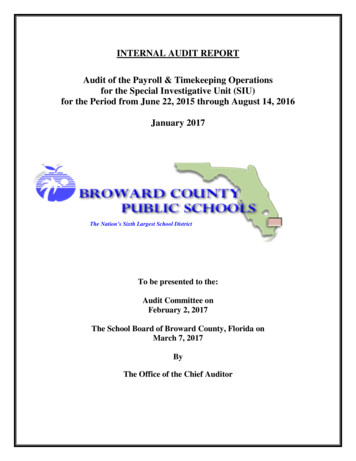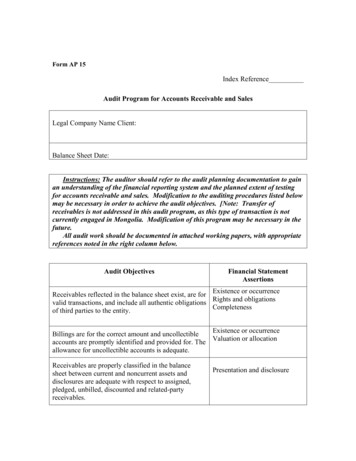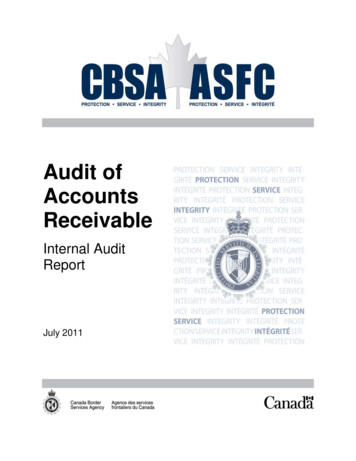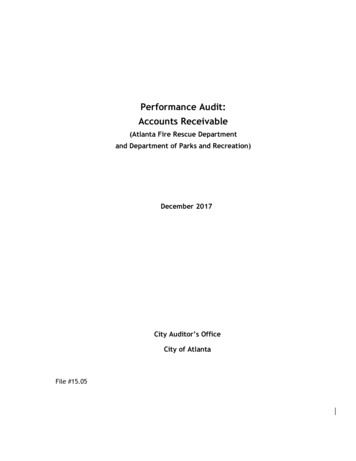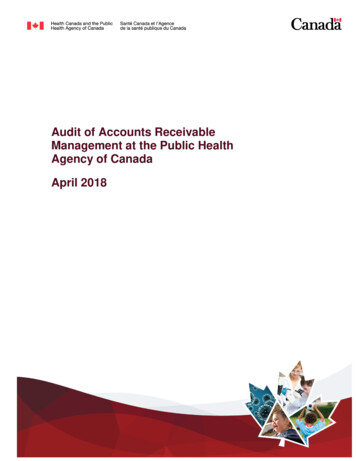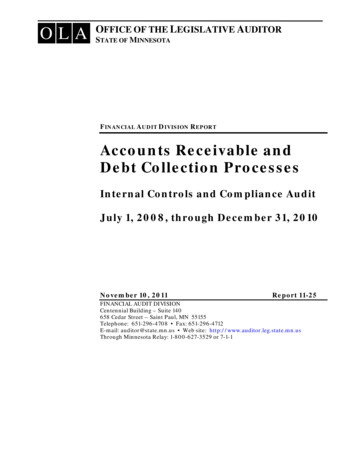
Transcription
OLAOFFICE OF THE LEGISLATIVE AUDITORSTATE OF MINNESOTAFINANCIAL AUDIT DIVISION REPORTAccounts Receivable andDebt Collection ProcessesInternal Controls and Compliance AuditJuly 1, 2008, through December 31, 2010November 10, 2011Report 11-25FINANCIAL AUDIT DIVISIONCentennial Building – Suite 140658 Cedar Street – Saint Paul, MN 55155Telephone: 651-296-4708 Fax: 651-296-4712E-mail: auditor@state.mn.us Web site: http://www.auditor.leg.state.mn.usThrough Minnesota Relay: 1-800-627-3529 or 7-1-1
OLAOFFICE OF THE LEGISLATIVE AUDITORState of Minnesota James Nobles, Legislative AuditorNovember 10, 2011Representative Michael Beard, ChairLegislative Audit CommissionMembers of the Legislative Audit CommissionJames Schowalter, CommissionerDepartment of Management and BudgetMyron Frans, CommissionerDepartment of RevenueThis report presents the results of our internal controls and compliance audit of the state’saccounts receivable and collection processes for the period July 1, 2008, through December 31,2010. Our audit scope included the departments of Management and Budget, Revenue,Administration, and Human Services, the Pollution Control Agency, and the State CourtAdministrator’s Office for the management and collection of receivables.The audit was conducted by David Poliseno, CPA, CISA, CFE (Audit Manager) and TracyGebhard, CPA (Auditor-in-Charge), assisted by Kayla Borneman, CPA, Lindsay Tietze, CPA,and Reidar Gullicksrud.This report is intended for the information and use of the Legislative Audit Commission and themanagement of the departments of Management and Budget, Revenue, Administration, andHuman Services, the Pollution Control Agency, and the State Court Administrator’s Office. Thisrestriction is not intended to limit the distribution of this report, which was released as a publicdocument on November 10, 2011.We received the full cooperation of the departments of Management and Budget, Revenue, andthe other agencies included in our scope, and we thank them for their assistance.James R. NoblesLegislative AuditorCecile M. Ferkul, CPA, CISADeputy Legislative AuditorRoom 140 Centennial Building, 658 Cedar Street, St. Paul, Minnesota 55155-1603 Tel: 651-296-4708 Fax: 651-296-4712E-mail: auditor@state.mn.us Web Site: www.auditor.leg.state.mn.us Through Minnesota Relay: 1-800-627-3529 or 7-1-1
Accounts Receivable and Debt Collection ProcessesTable of ContentsPageReport Summary .1Overview.3Objective and Scope .4Methodology .5Conclusion .6Findings and Recommendations .91.The Department of Management and Budget did not providesufficient oversight and guidance to state agencies for their accountsreceivable.92.The Pollution Control Agency did not design, implement, and monitorfundamental internal controls over its receipts process .113.The Pollution Control Agency did not properly record, document, andmonitor its accounts receivable .134.The Pollution Control Agency did not properly manage or activelypursue collection of some outstanding receivables .145.Three agencies allowed employees to have incompatible access toagency subsystems without establishing mitigating controls .156.The Department of Revenue and the Pollution Control Agencyallowed employees to have unnecessary access to their subsystems .177.The State Court Administrator’s Office was not able to identify,account for, and report the amount of outstanding receivables to theDepartment of Management and Budget .18Agency Responses .19Management and Budget .19Revenue .21Employment and Economic Development .25Enterprise Technology.27Human Services .29Minnesota Judicial Branch .31Pollution Control Agency .35
Minnesota Office of the Legislative Auditor1Report SummaryConclusionThe internal controls at the Department of Management and Budget weregenerally adequate to ensure that state agencies reported complete, prompt, andaccurate accounts receivable information; however, the department did not alwayscomply with its policies.The internal controls at the Department of Revenue’s Collection Division wereadequate to ensure it properly recorded, pursued, and deposited the collection ofdebt and remitted the correct amount of debt collected to the applicable funds andreferring agencies.Except for the Pollution Control Agency and the State Court Administrator’sOffice, the internal controls at the state agencies we reviewed were generallyadequate to ensure that they reported complete, prompt, and accurate accountsreceivable information to the Department of Management and Budget.Except for the Pollution Control Agency, all of the agencies we tested generallyhad adequate internal controls to ensure they pursued the collection of accountsreceivable and submitted past due accounts receivable to the Department ofRevenue’s Collection Division, as required by state policy.For the items tested, except for the Pollution Control Agency, the agencies wetested generally complied with significant finance-related legal requirements. ThePollution Control Agency did not comply with significant finance-related legalrequirements for the items tested.The findings in our report further explain the exceptions noted above.Key Findings The Department of Management and Budget did not provide sufficientoversight and guidance to state agencies for their accounts receivable.(Finding 1, page 9) The Pollution Control Agency did not design, implement, and monitorfundamental internal controls over its receipts process. (Finding 2,page 11) The Pollution Control Agency did not properly record, document, andmonitor its accounts receivable. (Finding 3, page 13)
2Accounts Receivable and Debt Collection ProcessesAudit Objectives and ScopeObjectives Internal Controls Legal ComplianceScope Accounts receivable and collectionfunctions for several state agenciesfrom July 1, 2008, throughDecember 31, 2010
Internal Controls and Legal Compliance Audit3OverviewAs of June 30, 2010, the State of Minnesota reported approximately 3 billion ofaccounts receivable in its audited financial statements. With the current economicconditions and the state’s significant budget challenges, it is increasinglyimportant for the state to accurately identify the amount it is owed and activelypursue the collection of receivables. This audit examined the adequacy of thestate’s internal controls to ensure it accurately reported and actively pursued thecollection of its accounts receivable during the timeframe of the audit.The Department of Management and Budget provides oversight of the state’sdecentralized accounts receivable and collection processes to state agencies. Statestatute requires the commissioner of the department to establish internalguidelines for the recognition, tracking, reporting, and collection of debts owedthe state.1 The department established policies and procedures over the state’saccounts receivable and required state agencies to submit accounts receivable datato the department quarterly.In the course of their operations, state agencies impose taxes, fees, penalties,fines, or charge for services they provide. Failure on the part of any party to makepayment in full results in an amount owed to the state and an “accountsreceivable.” Agencies are responsible for managing their receivables and pursuingcollection of the receivables. State policy establishes the collection processagencies are required to follow.2 The process requires agencies to contact thedebtor at least every 30 days through invoices, letters, or phone calls. State statuteand policies require agencies to submit receivables (except for child supportreceivables) that are 121 days past due and meet specific requirements to theDepartment of Revenue’s Collection Division.3For child support receivables, the Department of Human Services is not requiredto follow state policy or refer the debt to the Department of Revenue’s CollectionDivision. Instead, the department follows state statutes and its internal policy forcollection.4 The department uses a variety of methods to locate debtors, such asaddress searches and correspondence with federal agencies. In order to collect ona debt, the department uses enforcement remedies, such as wage garnishment;bank account levy; driver’s, recreational, and occupational license suspension;1Minnesota Statutes 2010, 16D.03.Department of Management and Budget Policy 0505-01.3Minnesota Statutes 2010, 16D.04 and the Department of Management and Budget’s policy notedin footnote 2.4Minnesota Statutes 2010, 518A.2
4Accounts Receivable and Debt Collection Processesand credit bureau notification. An outstanding receivable remains open until fullycollected, settled, or a new court order is issued.5The Department of Revenue’s Collection Division uses a variety of tools tocollect receivables. For example, the division uses revenue recapture, as stated instate statute and policy.6 Revenue recapture allows the division to apply a debt tothe amount of the debtor’s tax refund or lottery winnings. The division can alsoseize assets and property, establish liens, garnish bank accounts, create paymentplans, make settlements, etc. If, after five years, the division has not collected anoutstanding receivable, it remits it back to the referring agency for write-off orsubmission to a collection agency.With the exception of the Department of Revenue’s Collection Division, mostreceivable management and collection activities are decentralized through thestate agencies. In order for the Department of Management and Budget to providestatewide oversight of the decentralized receivable management process, statepolicy (in accordance with state statute) requires agencies to report their accountsreceivable information quarterly to the Department of Management and Budget.7Agencies must report certain accounts receivable information, including an agingof their accounts receivable, amounts written off greater than 5,000, and any pastdue accounts they submit to the Department of Revenue’s Collection Division oranother collection agency. For state agencies that do not have accounts receivable,the policy requires them to annually certify that information to the Department ofManagement and Budget instead of submitting the quarterly reports.8Objective and ScopeThe objective of our audit of the state’s accounts receivable and collectionfunctions was to answer the following questions:5 Did the Department of Management and Budget have adequate internalcontrols to ensure that state agencies reported complete, timely, andaccurate accounts receivable information?9 Did the Department of Revenue’s Collection Division have adequateinternal controls to ensure it properly recorded, pursued, and deposited thecollection of debt? Also, did the agency remit the correct amount of debtcollected to the applicable funds and referring agencies?A court order establishes legal child custody and support payments.Minnesota Statutes 2010, and Department of Management and Budget Policy 0506-05.7Minnesota Statutes 2010, 16D.03 and Department of Management and Budget Policy 0503-01.8Department of Management and Budget Policy 0503-01: Managing and Reporting AccountsReceivables.9Our audit focused on the Department of Management and Budget’s responsibility to overseestate agencies’ accounts receivable and collection processes, not on its ability to accurately reportaccounts receivable amounts in the state’s Comprehensive Annual Financial Report.6
Internal Controls and Legal Compliance Audit5 Did the agencies we tested have adequate internal controls to ensure theyreported complete, timely, and accurate accounts receivable information tothe Department of Management and Budget? Did the agencies we tested have adequate internal controls to ensure theypursued the collection of accounts receivable and submitted past dueaccounts receivable to the Department of Revenue Collection Division, asrequired by Department of Management and Budget Policy 0505-01? Did the agencies we tested comply with significant finance-related legalrequirements?Our scope included accounts receivable amounts from July 2008 throughDecember 2010. As of December 31, 2010, state agencies reported accountsreceivable totaling approximately 3.7 billion and an offsetting allowance fordoubtful accounts totaling about 1.7 billion. Based on the agencies’ reports,approximately 45 percent of the total related to child support receivable, 31percent
This report presents the results of our internal controls and compliance audit of the state’s accounts receivable and collection processes for the period July 1, 2008, through December 31, 2010. Our audit scope included the departments of Management and Budget, Revenue, Administration, and Human Services, the Pollution Control Agency, and the State Court Administrator’s Office for the .
